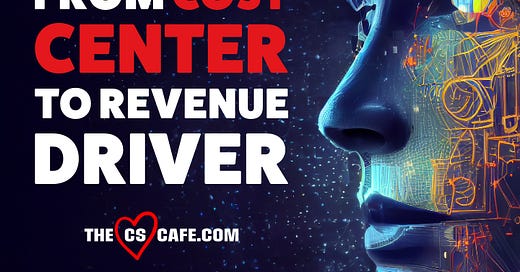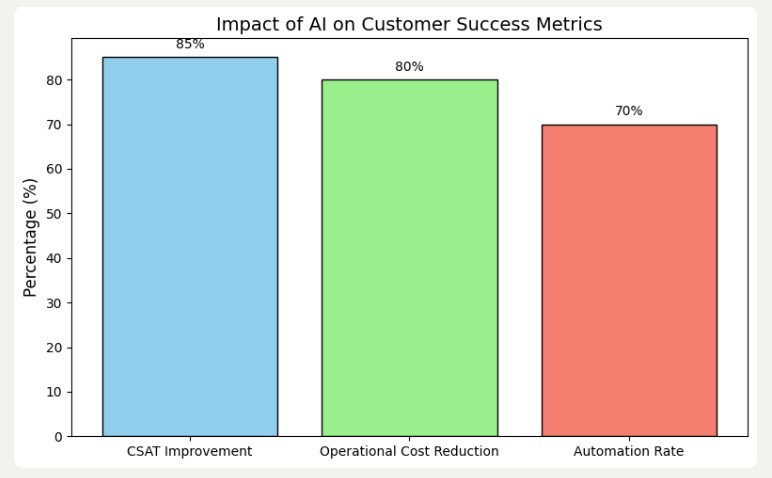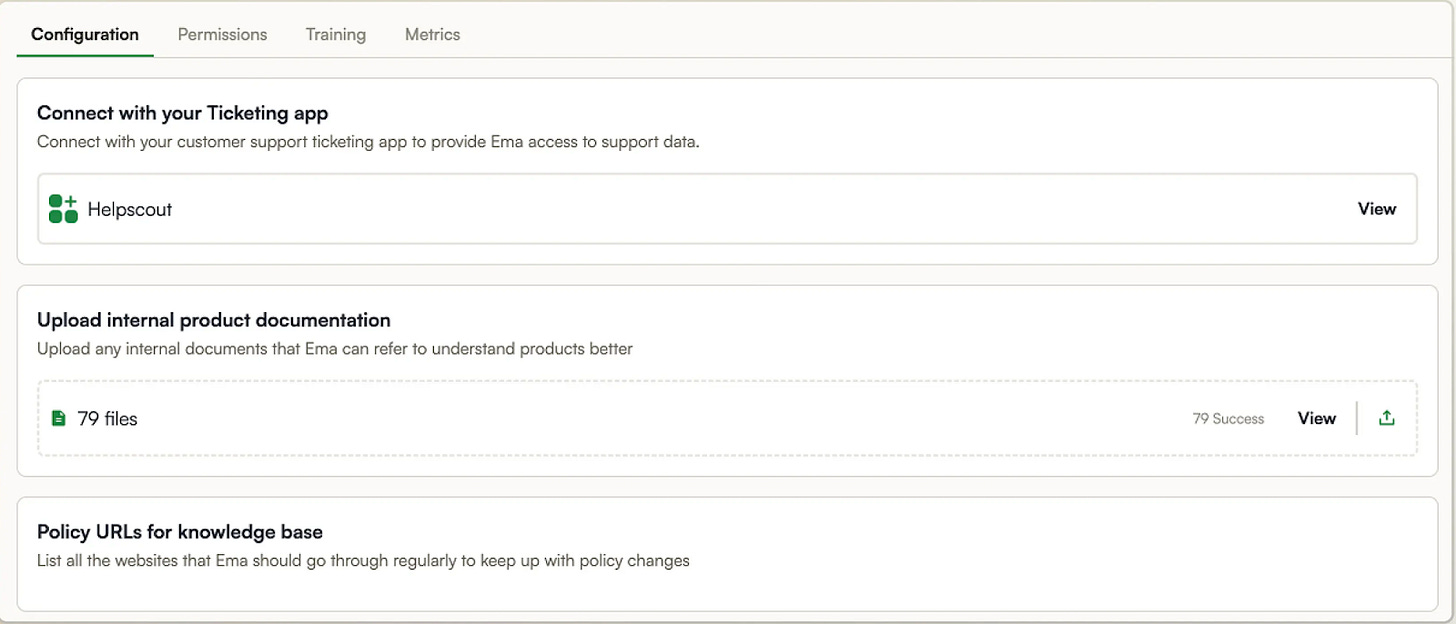AI Just Gave You a Seat at the Revenue Table
This article is sponsored by
With Ema, transform every stage of your customer lifecycle with a coordinated team of AI Employees. Brands have seen impressive results: 80% CSAT Improvement, >70% deflection of customer issues before they become tickets, and the ability to handle L2 and L3 tickets autonomously. Learn more about Ema's solutions →
Today’s edition at a Glance:
Earn Your Boardroom Seat: AI transforms CS data into executive insights—70% less firefighting, $420K uncovered revenue, 35% reduced churn—giving CS leaders the metrics that demand a permanent place at the strategic table
The 80% CSAT Advantage: Learn how companies like Moneyview, Bigblue, and Envoy are using Agentic AI to improve customer satisfaction dramatically while reducing operational costs
Reclaim Strategic Time: See how automating 70% of routine customer inquiries frees your team to focus on relationship-building and revenue opportunities
5-Step AI Implementation Blueprint: Follow the proven framework used by leading CS organizations to transform their operations
The Human+AI Partnership: Understand which tasks to automate and which require your team's strategic thinking for maximum impact
Customer Success has long battled the perception that it’s a cost center—an expense rather than a revenue driver.
But a revolution is underway, and I've seen it firsthand.
AI isn't just changing the tools CS teams use—it's fundamentally redefining their strategic value and how they position themselves within top leading organizations.
Based on what I've seen work for many members of the 4,200+ CS professionals in our community, let me show you exactly how this is happening.
Break Free from the Firefighting Trap
CS is not about putting out fires, though that's where many teams are still stuck.
The most impactful CS teams are now using AI to transform their operations from reactive firefighting to proactive value creation—and the transformation is fundamental.
The numbers tell the story better than I can:
Organizations that implement CS strategies based on AI see up to 85% improvement in customer satisfaction scores (CSAT) while reducing operational costs by 80% at the same time.
This isn't incremental improvement—it's a fundamental shift in how CS functions and delivers measurable business impact.
6 Game-Changing Applications for CS Teams Now
For teams looking to move beyond email automation and content creation, here are specific, high-impact AI applications that can help you deliver value right now:
1. Customer Health Monitoring
Set up an AI-powered health scoring that analyzes usage patterns, engagement metrics, and sentiment to identify at-risk accounts before they show obvious signs of churn
Set up automated alerts when customer health scores drop below certain thresholds
2. Intelligent Ticket Routing and Triage
Use AI to categorize and prioritize incoming customer requests based on urgency, complexity, and customer value
Route requests to the most qualified team member based on skill and capacity.
3. Personalized Onboarding Optimization
Analyze customer behavior to identify optimal onboarding paths for different customer segments
Deploy AI assistants that track onboarding progress and proactively identify potential roadblocks
4. Customer Intent and Sentiment Analysis
Set up tools that identify the underlying meaning behind your customer communications
Track sentiment changes over time to identify potential issues before they escalate
5. Proactive Risk Mitigation
Use predictive analytics to identify patterns that suggest a customer might churn
Create automated playbooks that trigger when risk indicators appear
6. Revenue Opportunity Identification
Deploy AI that identifies upsell and cross-sell opportunities based on usage patterns
Generate data-backed recommendations for account expansion
Predict & Prevent: How AI Ends the Reactive CS Cycle
These are the common challenges traditional CS teams face today:
Overwhelming customer requests that force teams into reactive mode
Repetitive queries consuming massive time per CSM
Limited scalability without proportional headcount increases
Missed revenue opportunities due to focus on solving immediate issues
AI is changing this equation.
It helps teams anticipate customer needs before problems arise.
According to recent research by Gartner, 59% of CX leaders expect that adopting AI will lead to increased customer loyalty and lifetime value.
The Strategic Goldmine: How AI Boosts CS Operations
The most significant transformation is more than just how CS teams respond to customers.
It’s in how they become strategic resources within the organization.
Set Your Team Free: How AI Crushes 70% of Routine Tasks
AI solutions like Ema can resolve over 70% of customer requests before they become service requests or escalations without any human touch.
This isn't just about efficiency – it's about freeing your team to focus on high-value activities that machines simply can't replicate.
When routine tasks are handled by AI, your team can focus and:
Build deeper customer relationships
Identify expansion opportunities
Develop strategic account plans
Create proactive success programs
Hidden Revenue Signals: Mining Customer Data for Growth
AI doesn't just solve problems—it uncovers patterns and opportunities hidden in customer interactions.
As AI analyzes massive amounts of customer data, it can identify:
Early warning signs of potential churn
Opportunities for upsell and cross-sell
Feature adoption gaps
Sentiment trends across customer segments
For example, Moneyview, a digital lending platform, implemented AI that not only resolved most of their customer requests autonomously but also identified patterns around monthly loan repayment deadlines that helped them proactively address customer concerns (Source: Ema)
💥Claim Your Boardroom Seat: CS as the New Strategic Hero
Perhaps the most significant transformation is how AI transforms CS from a cost center to a strategic asset to get a seat at the boardroom table.
Measurable Revenue Impact
As AI handles routine tasks, CS teams can focus on activities that directly impact revenue:
Churn reduction: Predictive analytics identify at-risk accounts before they churn
Expansion revenue: AI surfaces upsell opportunities based on usage patterns
Referral generation: Improved CSAT (up to 80% with AI implementation) leads to more referrals
Operational Efficiency at Scale
The financial impact extends beyond new revenue to significant operational efficiencies:
Reduced support costs: Companies using AI for customer assistance report up to an 80% reduction in operational costs
Improved scalability: Help more customers without proportional headcount increases
Faster resolution times: AI resolves issues in minutes rather than hours or days
Strategic Decision Support
AI transforms CS data from anecdotal feedback into strategic intelligence:
Product development prioritization based on customer interaction patterns
Market segmentation informed by usage and support trends
Competitive positioning guided by customer sentiment analysis
Your 5-Step AI Transformation Blueprint
For CS leaders ready to transform their operations with AI, here's the proven framework that many members of our 4,200+ CS professional community have used to drive significant results:
Step 1: Audit your current state
Conduct a time audit by tracking how your CS team allocates their hours across different activities for at least two weeks.
Identify which repetitive tasks consume the most bandwidth while delivering minimal strategic value.
Pay special attention to activities like routine email responses, basic troubleshooting, and administrative work that could be automated.
Most CS teams discover that 40-60% of their time is spent on tasks that don't directly contribute to strategic customer outcomes.
Step 2: Define clear objectives
Set specific, measurable goals for your AI implementation that align with broader business objectives.
For example, rather than simply stating "improve efficiency," target "reduce time spent on routine inquiries by 70% within 90 days" or "increase proactive outreach capacity by 15 hours per CSM per month."
The most successful CS transformations begin with outcome-focused objectives rather than technology-focused ones.
Make sure these objectives directly connect to revenue metrics like retention, expansion, or customer lifetime value.
Step 3: Select the right solution
Prioritize solutions that integrate seamlessly with your existing tech stack, in particular, your CRM and customer communication channels.
Evaluate options based on the implementation timeline, learning curve, and expected ROI.
The most effective CS teams focus on platforms that offer both immediate efficiency gains and long-term strategic capabilities.
💡Pro tip: Create a weighted scorecard that evaluates potential solutions across factors like integration capabilities, scalability, customization options, and vendor support quality.
Step 4: Start with high-impact, low-risk areas
Begin your implementation with routine queries that have clear resolution paths and well-defined outcomes.
Customer onboarding follow-ups, basic troubleshooting, and regular check-ins are excellent starting points.
This approach builds team confidence and creates quick wins that show value.
Starting with processes that affect 15-20% of customer interactions provides the ideal balance between meaningful impact and manageable change.
Step 5: Measure and optimize
Track metrics that directly connect to business outcomes:
Automated Resolution Rate, First Contact Resolution (FCR), CSAT, and most importantly—the revenue impact of your team's newly available strategic time.
Set a regular cadence for reviewing these metrics and refining your approach.
Run monthly reviews of automation performance and quarterly assessments of how the capacity they free up is being redirected to high-value activities.
The Human Advantage: What CS Pros Do Better Than Any AI
This transformation doesn't reduce the role of CS professionals—it amplifies it.
The most successful organizations are those that view AI as an improvement to their teams’ capabilities, not a replacement.
Example here with Human In The Loop—Ema sends a private note to the agent, briefing them about the solution they can offer:
When AI handles routine tasks, CS professionals can focus on what humans do best:
Building authentic relationships
Navigating complex emotional situations
Identifying creative solutions to unique challenges
Serving as strategic advisors to customers
Platforms that use AI Agents that are smart and know when to bring a human in the loop have become essential.
The Future Winners: How Strategic CS Teams Will Dominate
The CS teams that thrive will be those that embrace AI not just as a tool for efficiency but as a catalyst for strategic transformation.
They'll move beyond reactive support to become proactive value creators, trusted advisors, and strategic assets to their organizations.
So, the question CS leaders face isn't whether the should adopt AI but how quickly they can transform their teams, from cost centers to strategic assets that drive measurable business impact.
As part of my commitment to providing you with cutting-edge tools to our CS Café community, I've partnered with Ema to explore how their agentic mesh technology is helping CS teams handle routine tasks while enabling human agents to focus on relationship-building and revenue opportunities.
This partnership aligns with my mission to equip you with proven frameworks that drive boardroom-level impact.
These are the kinds of transformative outcomes that change how CS is perceived in the organization—and ultimately, how it contributes to the company’s bottom line.
The CS teams that embrace this shift won't just survive the AI revolution—they'll lead it.
I hope that helps,
-Hakan
Founder, The Customer Success Café Weekly Newsletter








